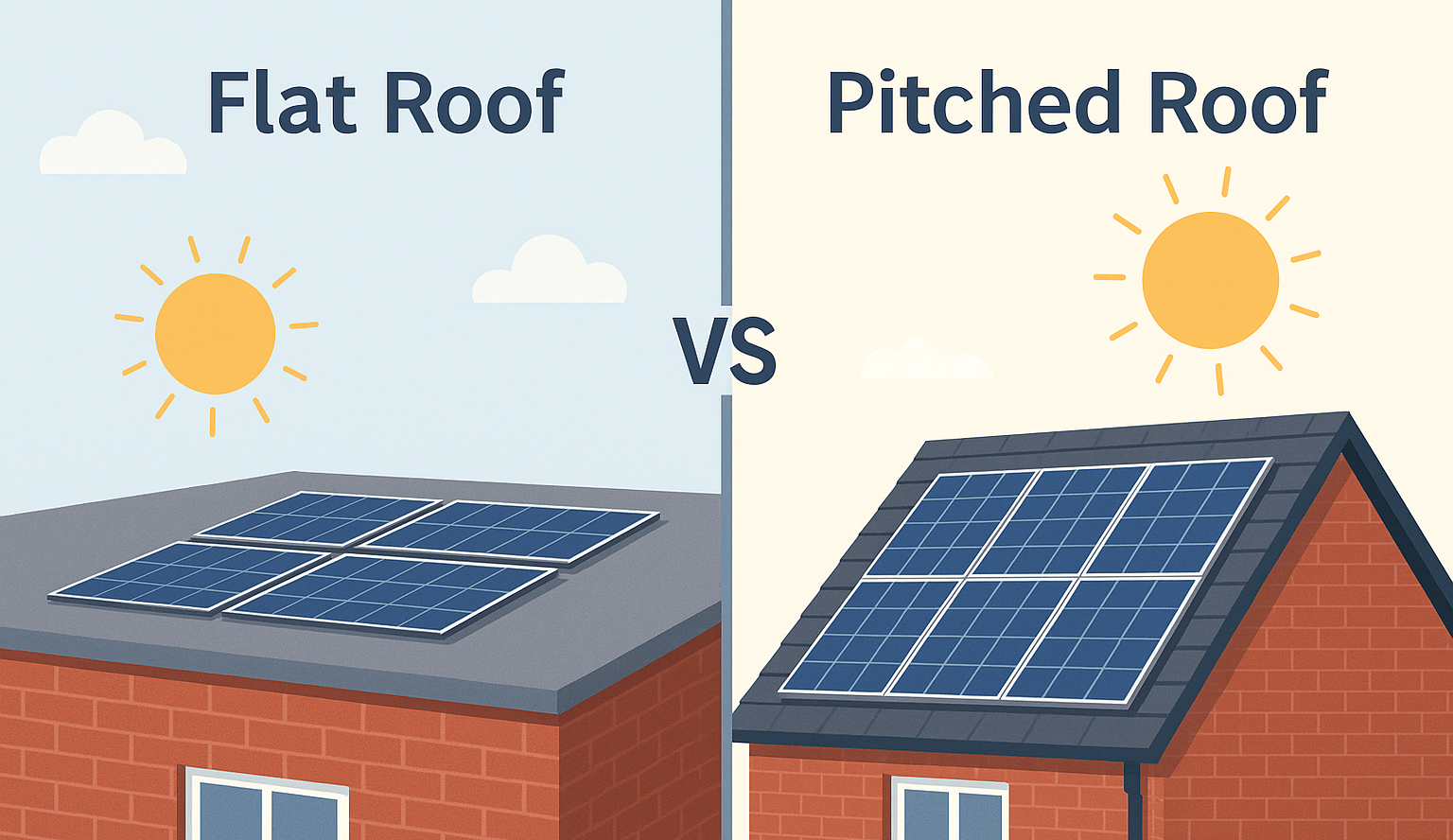

When deciding to invest in solar panels for your home or business, one important factor to consider is your roof type. Both flat and pitched roofs have their advantages and challenges when it comes to solar panel installation. Understanding how each performs can help you make an informed decision and maximise your energy savings.
The effectiveness of a solar panel system heavily relies on its orientation and tilt angle. In the UK, the optimal tilt angle for solar panels is generally between 30° and 40°, which aligns with the sun’s path to generate the most electricity throughout the year.
Pitched roofs naturally provide this angle, giving them an inherent advantage. Flat roofs, however, require mounting structures to tilt the panels to the correct angle, which introduces other considerations like weight, cost, and wind resistance.
Pitched roofs—commonly found on UK homes—tend to be well-suited for solar panel installation, and here’s why:
As mentioned, pitched roofs usually have a built-in tilt, making it easier to position panels at the ideal angle without needing additional mounting equipment.
Rainwater naturally runs off pitched roofs, which helps keep the solar panels clean and functioning efficiently. Dust, bird droppings, and debris are less likely to accumulate, reducing the need for frequent cleaning.
Solar panels on pitched roofs often look more integrated, especially when using in-roof mounting systems that sit flush with the tiles. This can be appealing for homeowners who value curb appeal.
With less need for custom mounting structures, pitched roof installations tend to be quicker and more affordable, making them a cost-effective choice.
While pitched roofs are advantageous, they’re not without challenges:
Access for installation and maintenance can be more difficult and may require scaffolding.
Some roof orientations, like north-facing pitches, are less efficient for solar generation.
Limited roof space on smaller houses can restrict how many panels can be installed.
Flat roofs, typically seen on commercial buildings or modern homes, offer unique flexibility for solar panel systems:
Unlike pitched roofs, where panel placement is limited by the roof’s direction, flat roofs allow you to freely orient panels to face true south, the most productive direction in the UK.
Flat roofs are easier to access, which simplifies installation and maintenance tasks. Technicians can safely work without extensive safety gear or scaffolding.
A flat roof gives you more freedom to experiment with advanced solar solutions, such as solar tracking systems that follow the sun’s movement for increased energy yield.
Since panels are installed horizontally or at a low tilt, they are often less visible from the ground, maintaining the building’s original appearance.
Despite the benefits, flat roof systems also have several challenges to consider:
Additional mounting hardware is needed to achieve the correct tilt angle, increasing costs.
Wind load can be an issue—tilted panels on flat roofs may act like sails, requiring secure anchoring.
Water drainage is less efficient, so regular maintenance is essential to ensure debris and standing water don’t impact performance.
Shading issues can occur if panels are installed in rows, as one row might cast shadows on another if not properly spaced.
In general, installing solar panels on a pitched roof is usually less expensive due to reduced hardware and labour requirements. However, flat roofs can offer better panel positioning and flexibility, which may result in higher energy output—balancing out the higher upfront cost over time.
Using a solar panel calculator can be helpful in this scenario. It allows you to input variables such as your roof type, system size, and orientation to estimate potential energy savings and return on investment.
In the UK, most solar panel installations fall under Permitted Development Rights, meaning you typically don’t need planning permission. However, flat roof installations with prominent tilt frames may exceed height limits or affect the building’s appearance, which could trigger the need for permission.
Always check with your local planning authority before proceeding, especially if your property is in a conservation area or is listed.
There’s no one-size-fits-all answer. Your choice depends on your roof’s characteristics, your budget, and your energy goals.
Choose pitched roof installation if your roof is south-facing, has good tilt, and you want a cost-effective and quick solution.
Choose flat roof installation if you want full control over orientation, have space to spare, and are willing to invest slightly more for customisation and potentially better performance.
Consulting with a certified solar installer can help assess your property and provide tailored recommendations.
If you need help with this topic then please fill out the form below and we'll put you in touch with an expert architect local to you who can help. Alternatively you can email us: email us